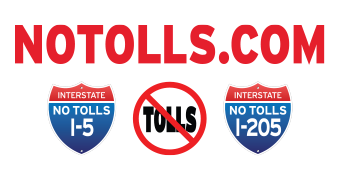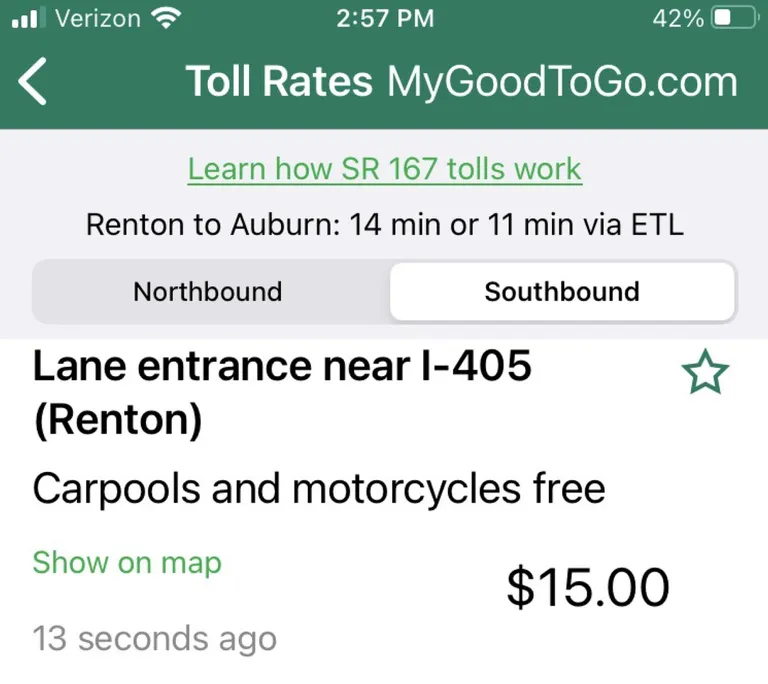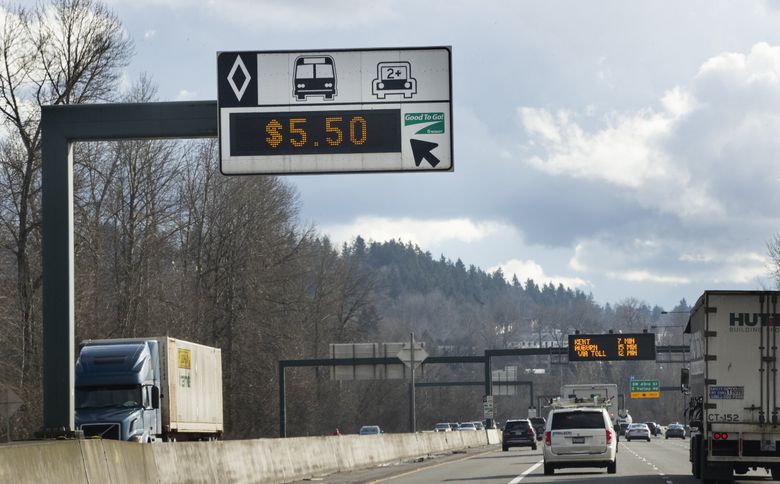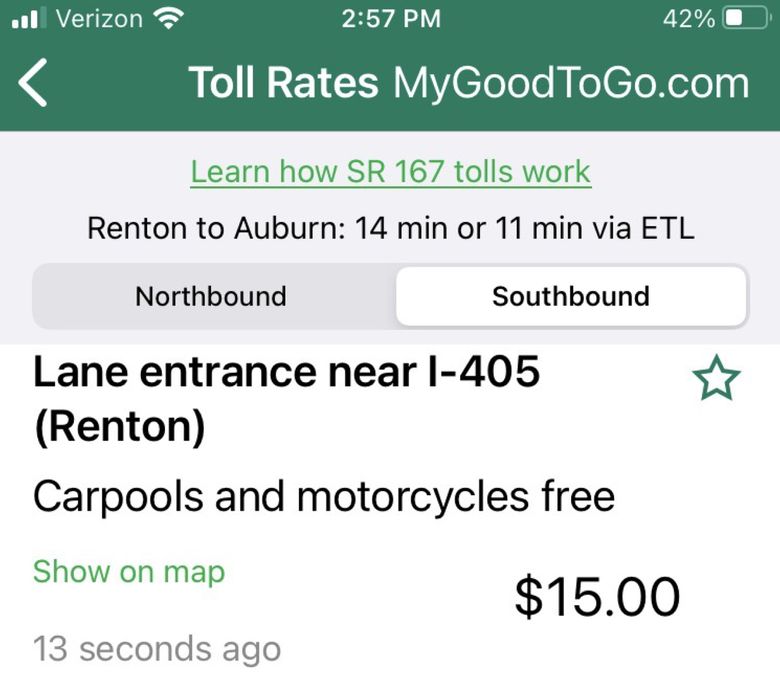Westneat: Bring on the infinity tolling
Don was out on the Valley Freeway the other day, headed south from Renton toward Auburn, when he noticed something curious. Something very Seattle.
He dropped me an email at 2:57 p.m.: “I think I found those millionaires you were looking for.”
Attached was a screenshot of the real time tolling rates for the Highway 167 express lane. It’s a “fast lane” that solo drivers can pay to use, or drive in the general lanes for free.
The toll is a free-market feedback system — the more congested the traffic, the higher it goes. The theory is that only a fraction of drivers will pay the top rates, keeping the lane moving fast.
A few months ago, the state acknowledged it had run up against the reality of the area’s 54,200 millionaires that I wrote about the other day. Officials boosted the max toll from $10 to $15, as so many drivers were paying that the “Lexus lanes” were often as clogged as the free ones.
This new $15 toll, though, is also proving to be but a bug on the windshield of Seattle wealth.
This past Thursday, they’d hit the max toll before 3 in the afternoon. What piqued driver Don’s interest were the travel times. The system said it was 14 minutes from Renton to Auburn in the general lanes, and 11 minutes in the special toll lane.
“People are willingly forking over $15 to go three minutes faster,” he reported. “What a world.”
Enough drivers paid the max $15 toll that the 167 fast lane had slowed to 16 minutes within an hour, versus 21 minutes in the free lanes, according to the Good To Go! mobile app.
Over on the Eastside, on Interstate 405 between Bellevue and Lynnwood, the toll maxed out at $15 on Thursday for more than three hours. So many drivers paid it that the fast lane eventually slowed to a crawl. (A collision in Bothell also hindered the entire network.)
I am so Midwest cheap that $15 tolls seem nuts to me. I drive around on the Interstate 90 bridge to avoid the 520 bridge tolls, which are only $3 or $4.
For the Seattle area, though, the problem isn’t that the new $15 Lexus lane tolls are too high. They’re already too low.
“If you raised the tolls to $50, plenty of people here would still pay it,” suggests Will Knedlik, of the group Washington State Good Roads and Transportation Association. “Somewhere is a point of equilibrium, but we are nowhere near reaching it.”
This is a prime signal of how frothy the region’s wealth has become. As well as how it can exert subtle pressure on people down the economic ladder.
The Lexus lanes are voluntary, so regular schmoes, or cheap bastards like me, don’t have to pay if they don’t want to. Yet as the toll price goes up, drivers are meant to opt out of the fast lane into the regular lanes instead.
So if the toll ratcheting works, the lanes for the schmoes get more crowded. By design. While the Lexus lanes get more … Lexusy.
Knedlik said the toll lanes tend to be used by “people who have so much money that these tolls mean nothing to them,” or by employees who get the tolls paid by their companies.
“There’s no question these lanes are generally off-limits to regular people and poor people,” he said.
The one democratic thing is that carpoolers can ride in the Lexus lanes for free. The wealthy of course can simply buy their way out of this democratic, environmental option. Story of our times.
It was interesting that this past week, New York shelved a $15 toll. It was a proposed congestion pricing scheme in which drivers would have to pay $15 to enter lower Manhattan. The politics is thick, but the governor cited the wealth gap.
“Let’s be real: A $15 charge may not mean a lot to someone who has the means, but it can break the budget of a working- or middle-class household,” Gov. Kathy Hochul said. “It puts the squeeze on the very people who make this city go: the teachers, first responders, small business workers, bodega owners.”
That squeeze is real. And yet at the same time, I bet New York would have discovered that they also have so many millionaires that a $15 toll would have proved too low to really ease congestion anyway.
Back to our Lexus lanes. Some days they work better than the day described above (though 167 southbound was again maxed at $15 on Friday). But one tolling expert suggested last fall that the long-term answer would be to go free market casino with the roadways. Let the toll float as high as drivers wish to pay — $20, $50, no limit.
“If you have a cap, it kind of stands in the way of the market clearing the lanes,” he said.
Sure, clearing the lanes … of the riffraff. Of course that expert is also proving to be right. If we have drivers paying $15 to save only three minutes, then for the tolls to work it’s sadly inevitable they’ll need to rise.
Bring on the infinity tolling, I guess. Might as well if we’re selling road access to the highest bidders. It’d be a test — we’d finally get a glimpse of just how much disposable income is sloshing around in crazy rich Seattle.
But if you need to reach me that day, I’ll be working from home.





